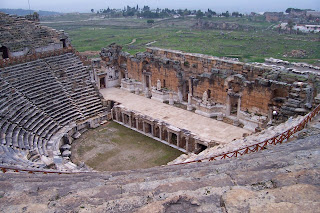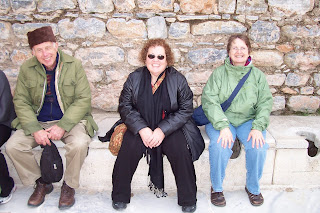
Today we turned our journeys inland, away from the seas and sites which once were ports and looked to the mountains. We drove to Sardis where we visited the 3rd largest Temple to Artemis in Turkey. Unlike temples to other Greek and Roman gods which faced east—the rising sun, a temple to Artemis faced west—symbolizing the importance of the moon to this goddess of the hunt. Lisa S. noticed that the view straight from the temple door is of a mountain outcrop that looks like the moon rising over the earth.

I noticed a shepherd herding his flock of sheep in the distance on a road separating one vineyard from another.
 Behind the temple was a hill, from which when we climbed it, we watched a farmer breaking up the soil. When I turned back around to face the temple, I noticed the ruins of a small church. Hmmm, before this city was abandoned, Christians had begun to worship here.
Behind the temple was a hill, from which when we climbed it, we watched a farmer breaking up the soil. When I turned back around to face the temple, I noticed the ruins of a small church. Hmmm, before this city was abandoned, Christians had begun to worship here. 
All in all, the views here were very pastoral.
Next we drove to another part of the site that was the city of Sardis. It housed both a synagogue and a gymnasium, side by side. Now from what we read in the Old Testament and from what we read in Jewish midrash, you would think that a synagogue would never have been next door to a gymnasium, where athletes worked out in the nude. But here we have evidence that both were indeed side by side.
 We wondered if perhaps the Jews in the diaspora modified and adjusted their way of living. One of the participants in our tour reminded us of how the Vatican may proclaim the official stand the Catholic church is making, but many Catholic people harbor their own (very different) views—and don’t hesitate to share those views with their non-Catholic friends and neighbors.
We wondered if perhaps the Jews in the diaspora modified and adjusted their way of living. One of the participants in our tour reminded us of how the Vatican may proclaim the official stand the Catholic church is making, but many Catholic people harbor their own (very different) views—and don’t hesitate to share those views with their non-Catholic friends and neighbors. We also saw some beautiful geometric designs of tiles in the walls here. Having been a high school math teacher (teaching Honors Geometry for several years) in a "previous" (as in pre-seminary) life, I just had to snap these shots of some great tessellations.


Our visit to Sardis ended, we ate lunch and began a 2 hour drive to Pamukkale, a resort area where calcium in the water has left white deposits on the cliffs. The springs here are warm year-round, so naturally several of us had to wade in them. This warm springs area was jam-packed with tour buses and tourists—even though it was raining and cold.

We walked all around the cliffs until we reached Hierapolis, yet another site of Roman ruins. We took a cursory look at the theater here and then began a trek up the hill behind it to visit the ruins of the church of St. Philip.
 At one point, our tour guide and his wife stopped and shared a somewhat heated exchange in Turkish. She turned and walked one way, he another. I called out to her asking where she was going. She replied she was taking a different route which would be slightly longer. Our guide replied his way was shorter but steeper. I followed her. Not only did we not have to climb the steep incline he climbed, but we also arrived at the church sooner than the group which went with him.
At one point, our tour guide and his wife stopped and shared a somewhat heated exchange in Turkish. She turned and walked one way, he another. I called out to her asking where she was going. She replied she was taking a different route which would be slightly longer. Our guide replied his way was shorter but steeper. I followed her. Not only did we not have to climb the steep incline he climbed, but we also arrived at the church sooner than the group which went with him. The church had a series of arches with different kinds of crosses etched above each doorway.
 It also had red marble on the floor by the front doorway. Lisa S. postulated that the red marble signified the martyred death of Philip.
It also had red marble on the floor by the front doorway. Lisa S. postulated that the red marble signified the martyred death of Philip.  Since it was getting dark, we began our trek downhill. I followed our guide’s wife on yet another different route. Unlike the others, we avoided the deep and many water puddles. By the time we arrived at the place we had agreed to meet those in our group who had not chosen to hike up to the church, it was dark. But the white cliffs area of the warm springs was well lit with street lamps, so we were able to hike back to the bus safely.
Since it was getting dark, we began our trek downhill. I followed our guide’s wife on yet another different route. Unlike the others, we avoided the deep and many water puddles. By the time we arrived at the place we had agreed to meet those in our group who had not chosen to hike up to the church, it was dark. But the white cliffs area of the warm springs was well lit with street lamps, so we were able to hike back to the bus safely. The hotel was full—a first and only for us on this trip—with other tourists. Fortunately for us, the warm springs were large enough for so many guests at once. We did not have to wait on any group to see any of the sites here. But, it did help us to appreciate how fortunate we have been elsewhere on our trip—having the run of each site.
Here are more pictures from this day in Turkey.











































